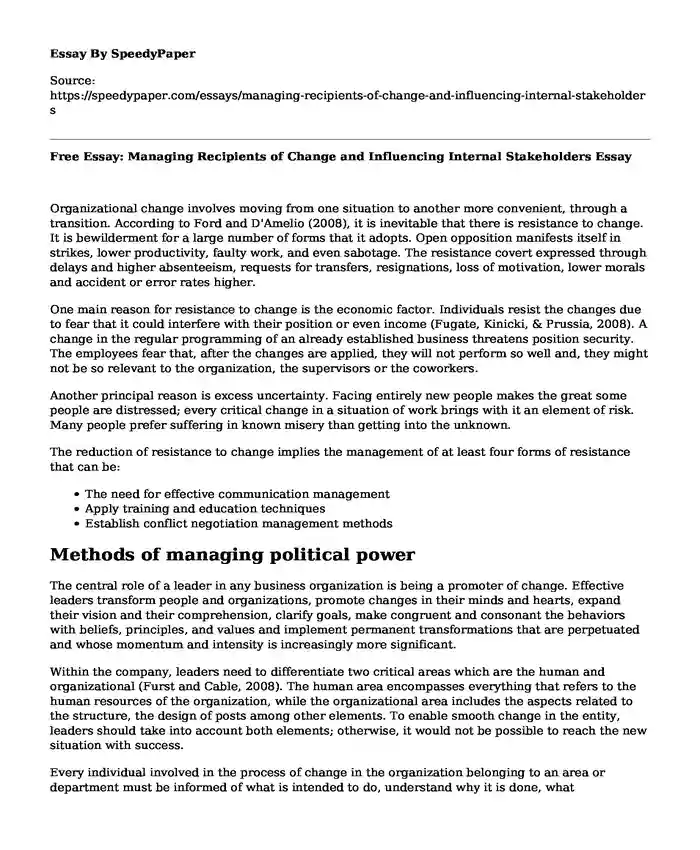
| Type of paper: | Critical thinking |
| Categories: | Management Business strategy |
| Pages: | 3 |
| Wordcount: | 611 words |
Organizational change involves moving from one situation to another more convenient, through a transition. According to Ford and D'Amelio (2008), it is inevitable that there is resistance to change. It is bewilderment for a large number of forms that it adopts. Open opposition manifests itself in strikes, lower productivity, faulty work, and even sabotage. The resistance covert expressed through delays and higher absenteeism, requests for transfers, resignations, loss of motivation, lower morals and accident or error rates higher.
One main reason for resistance to change is the economic factor. Individuals resist the changes due to fear that it could interfere with their position or even income (Fugate, Kinicki, & Prussia, 2008). A change in the regular programming of an already established business threatens position security. The employees fear that, after the changes are applied, they will not perform so well and, they might not be so relevant to the organization, the supervisors or the coworkers.
Another principal reason is excess uncertainty. Facing entirely new people makes the great some people are distressed; every critical change in a situation of work brings with it an element of risk. Many people prefer suffering in known misery than getting into the unknown.
The reduction of resistance to change implies the management of at least four forms of resistance that can be:
- The need for effective communication management
- Apply training and education techniques
- Establish conflict negotiation management methods
Methods of managing political power
The central role of a leader in any business organization is being a promoter of change. Effective leaders transform people and organizations, promote changes in their minds and hearts, expand their vision and their comprehension, clarify goals, make congruent and consonant the behaviors with beliefs, principles, and values and implement permanent transformations that are perpetuated and whose momentum and intensity is increasingly more significant.
Within the company, leaders need to differentiate two critical areas which are the human and organizational (Furst and Cable, 2008). The human area encompasses everything that refers to the human resources of the organization, while the organizational area includes the aspects related to the structure, the design of posts among other elements. To enable smooth change in the entity, leaders should take into account both elements; otherwise, it would not be possible to reach the new situation with success.
Every individual involved in the process of change in the organization belonging to an area or department must be informed of what is intended to do, understand why it is done, what involvement is going to have all this and above all to participate in it. Leaders need to assess the emotional needs of individuals fail to which can cause problems of adaptation of people to this new situation where resistance comes in
Change must always be understood as a process, whose management involves carrying out a series of activities, using various tools that are considered necessary for the adaptation of the company to variations in the environment, so that competitive advantages are created or maintained.
References
Ford, J. D., Ford, L. W., & D'Amelio, A. (2008). Resistance to change: The rest of the story. Academy of management Review, 33(2), 362-377.
Fugate, M., Kinicki, A. J., & Prussia, G. E. (2008). Employee coping with organizational change: An examination of alternative theoretical perspectives and models. Personnel Psychology, 61(1), 1-36.
Cook, C. W., Hunsaker, P. L., & Coffey, R. E. (2001). Management and organizational behavior.
Oreg, S. (2006). Personality, context, and resistance to organizational change. European journal of work and organizational psychology, 15(1), 73-101.
Furst, S. A., & Cable, D. M. (2008). Employee resistance to organizational change: Managerial influence tactics and leader-member exchange. Journal of Applied Psychology, 93(2), 453.
Spector, B. (2010). Implementing organizational change: Theory into practice. Upper Saddle River, NJ: Prentice Hall.
Cite this page
Free Essay: Managing Recipients of Change and Influencing Internal Stakeholders. (2022, Sep 12). Retrieved from https://speedypaper.net/essays/managing-recipients-of-change-and-influencing-internal-stakeholders
Request Removal
If you are the original author of this essay and no longer wish to have it published on the SpeedyPaper website, please click below to request its removal:
- Marcus Garvey Essay Example
- Economics Paper Example: Microeconomic Reasons for Government Involvement
- Thakkar's Image of Africa
- Essay Sample: Glenn Gould the Pianist
- Essay Sample: Management in Practice (Positive Behavior in Classroom Management)
- Research Paper on The Mid-Twentieth Century Civil Rights Movement
- Free Essay Sample - Gods
Popular categories




